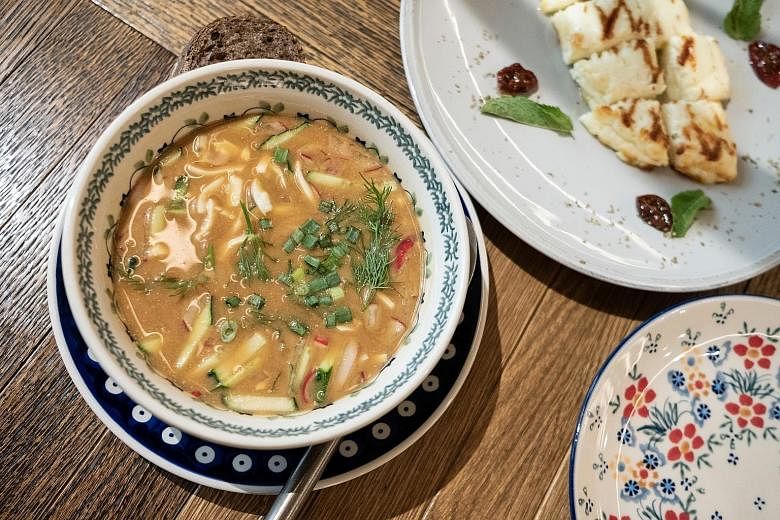KNYAZHEVO (Russia) • The homemade hooch was 110 proof. And the grilled pork with green garlic and Russian-made halloumi were grilled to perfection on an open fire.
Foodies and farmers gathered at a recent festival to toast what they consider one of their greatest triumphs in recent years: the revival of traditional Russian cuisine.
Forget the grey "mystery meat" and blobs of mayonnaise and canned peas posing as salads that became synonymous with the drab Soviet era. Enter lilac jam, stinging nettle pesto, horseradish-pickled tomatoes and braised ox with morel mushroom sauce.
"It's not a pizza. It's not a burger, but something which our parents and grandparents ate," said Mr Boris Akimov, 41, a food entrepreneur and champion of Russia's growing farm-to-table movement.
It takes its cues from more than a century ago, trying to tap into the traditional tastes before the Russian Revolution of 1917 and the concept of food manufactured for the masses. There is also a pinch of look-local nationalism in response to international sanctions.
"Russian cuisine is becoming important for Russians because, for a long time, maybe a century, they forgot about it," said Mr Akimov.
A year ago, he and his wife, chef Olga Strizhibikova, opened a tiny locavore restaurant, 145km north-east of Moscow in Knyazhevo. They hope to reinvigorate the sense of community they say was wiped out during seven decades of Soviet Union rule.
Last month, their four-table restaurant became the focal point in a festival where makers of honey-sweetened gingerbread, cloudberry cakes and cheese gathered to eat and sell their goods.
The food served in the restaurant, called simply Food And Farm, is fresh and seasonal, grown nearby.
Pigs, geese and turkeys occupy sheds beside dairy cows. Mounds of fresh, day-old brynza cheese hang in scarves-turned-cheesecloths.
It is the same farm that supplies Mr Akimov's Moscow restaurant, LavkaLavka, one of a growing number of places serving stylishly presented, delectable Russian food.
The culinary scene in Moscow has rapidly transformed in recent years, and the once-overpriced and unpalatable capital now teems with trendy eateries offering fresh scallops from Russia's Pacific Coast and pumpkin-stuffed chudu, a flatbread staple eaten in the North Caucasus.
Russian dishes are still a long way from gaining an international following. Mr Akimov suggested that shchi, a traditional soup made with fermented cabbage, meat broth and vegetables, could fit a niche. Its sour-salty taste is very Russian.
Russian hankering for salty, rubbery halloumi and herb-encrusted Belper Knolle cheeses is what led Ms Anna Rybnikova to quit her frenetic Moscow lifestyle and move to the countryside near Knyazhevo to become a full-time cheese-maker four years ago.
Her 18 cows produce 24 types of cheese, which she sells to Moscow markets.
"People have started to value natural products," she said. "There came a point when they disappeared from the city and became impossible to buy. People missed them."
WASHINGTON POST

